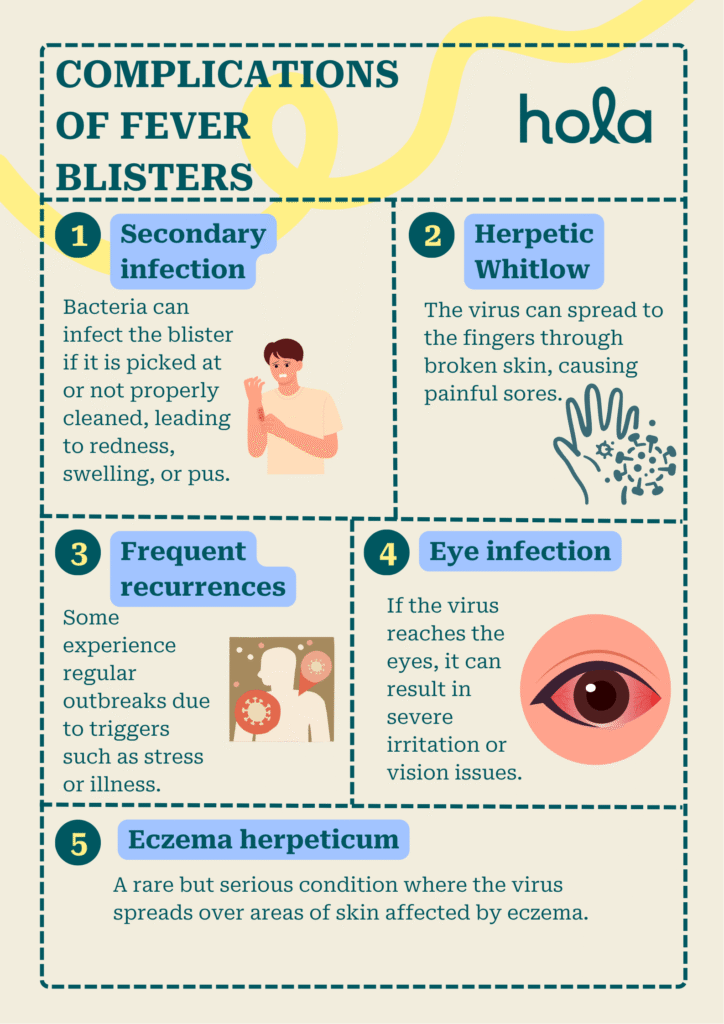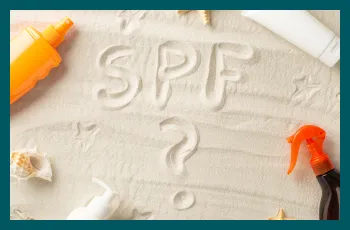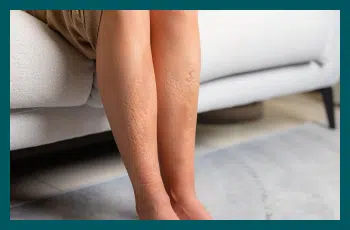Fever blisters: Stages, causes, and treatment
Written by the editorial staff writer at Hola. Medically Reviewed by Dr. Ammar AL-ANI, MBChB, CCBST, AMC.

Contents

Summary: Fever blisters, caused by the herpes simplex virus, go through five phases—from initial tingling to healing. Triggers include emotional strain, sickness, and exposure to sunlight. While there is no cure, antiviral drugs, non-prescription products, and home remedies help ease symptoms and reduce outbreaks. Prevention includes avoiding triggers and supporting a healthy immune response.
Fever blisters, also known as cold sores, are small, painful lesions that commonly develop near the lips, mouth, or nose. Caused primarily by the herpes simplex virus 1 (HSV-1), these blisters are a prevalent viral condition that impacts millions globally. Around 75% of the Australian population has been exposed to the HSV-1 virus, highlighting its widespread presence. Although typically not severe, fever blisters can be uncomfortable, contagious, and recurrent. Gaining insight into their stages, underlying causes, and treatment options is essential for managing them effectively.
What is a fever blister?
A fever blister, also known as a cold sore, is a tiny, fluid-filled blister that generally forms on or near the lips. It is caused by the herpes simplex virus type 1 (HSV-1) and is highly contagious. Fever blisters typically begin with a tingling or burning sensation, progressing to blister formation, crusting, and ultimately healing within 7-10 days.What causes fever blisters (cold sores)?
Fever blisters, also known as cold sores, are triggered by the herpes simplex virus type 1 (HSV-1). After an initial infection, this virus remains in your body and can reactivate later, often due to specific factors. Common triggers include:- Stress
- Illness or fever
- Sun exposure
- Hormonal shifts (such as menstruation)
- Weakened immune system
Also read: 6 Common skin conditions in Australia with prevention tips
Are fever blisters contagious?
Yes, fever blisters (or cold sores) are very contagious. They result from the herpes simplex virus type 1 (HSV-1), and transmission can occur through close interactions, such as kissing, sharing drinks, utensils, towels, or even touching the sore and then contacting your face or someone else’s. They are at their most contagious when the blister is open and leaking, although the virus can still spread even when sores are not visible. To prevent transmission, it’s best to avoid close contact and sharing personal items during an outbreak.
Feeling sick and unsure why? Speak with a GP online in 15 minutes.
Early stages of fever blister
The initial stages of a fever blister (cold sore) typically begin with a tingling, burning, or itching feeling around the mouth or lips. This prodrome phase can start 1 to 2 days before a blister forms. The area may feel sore, swollen, or slightly red. Shortly after this, small, painful blisters usually develop in clusters. Acting promptly with antiviral creams or medications during this phase can help lessen the severity and duration of the outbreak.Fever blister vs. pimple: what’s the difference?
A fever blister (cold sore) is caused by the herpes simplex virus (HSV-1), while a pimple results from clogged pores due to oil, dead skin, or bacteria. Fever blisters generally appear on or near the lips, start with a tingling or burning sensation, and evolve into fluid-filled blisters that may burst and form scabs.
Pimples can occur on any part of the face or body, are not contagious, and may present as a whitehead, blackhead, or red bump. Unlike pimples, fever blisters are highly contagious and often recur in the same location.
Also read: Red spots on skin: Causes & when to worry?
Treatments for fever blisters
Though fever blisters (cold sores) cannot be completely cured, there are treatments available that can help relieve symptoms and hasten recovery.
- Antiviral medications: Prescription antiviral drugs can shorten the duration and intensity of outbreaks. They are most effective when taken at the first indication of symptoms.
- Over-the-counter creams: Some products may help reduce healing time if applied early.
- Pain relief: Topical anaesthetics or oral pain relievers can be used.
- Home care: Keep the area clean and dry, avoid picking at blisters, and apply lip balm with SPF to protect against flare-ups triggered by sun exposure.
What are the complications of fever blisters?
Although fever blisters (cold sores) typically heal naturally, complications can arise, particularly in individuals with weakened immune systems. Possible complications include:
- Secondary infections – Bacteria can infect the blister if it is picked at or not properly cleaned, leading to redness, swelling, or pus.
- Herpetic whitlow – The virus can spread to the fingers through broken skin, causing painful sores.
- Eye infection (herpes keratitis) – If the virus reaches the eyes, it can result in severe irritation or vision issues.
- Frequent recurrences – Some individuals experience regular outbreaks due to triggers such as stress or illness.
- Eczema herpeticum – A rare but serious condition where the virus spreads over areas of skin affected by eczema.
If you notice worsening symptoms, spreading sores, or any eye pain, it is important to consult a doctor promptly.

When to see a doctor for a fever blister
Consult a doctor for a fever blister if it fails to heal within 10 to 14 days, is extremely painful, reoccurs frequently, or extends to your eyes. It's also important to seek medical attention if you have a compromised immune system, experience a high fever, or observe swelling in your lymph nodes. Although most cold sores resolve without intervention, medical treatment can assist in alleviating severe symptoms, decreasing the likelihood of recurrence, and preventing complications such as secondary infections or involvement of the eyes.
Conclusion
In conclusion, fever blisters are a common consequence of HSV-1 exposure, affecting a significant portion of the population. While permanent care is not available, understanding the stages, triggers, and treatment options can help alleviate symptoms and prevent outbreaks.
FAQs
What does a fever blister look like in the early stages?
In the early stages, a fever blister may not be visibly obvious, but you may experience tingling, itching, or burning sensations on the lips or around the mouth. Within a few days, small red bumps or tiny fluid-filled blisters may begin to form.
Are fever blisters and pimples the same?
No, fever blisters are caused by the herpes simplex virus and usually appear as fluid-filled blisters, often around the mouth. Pimples are caused by blocked pores and appear as inflamed bumps, sometimes with pus, typically on the face or body.
Are fever blisters contagious to babies?
Yes, fever blisters are highly contagious to babies. The herpes simplex virus can be dangerous for infants, especially newborns. Avoid close contact or kissing during an outbreak.
How long do fever blisters last?
Fever blisters typically last 7 to 10 days. They progress through stages—tingling, itching, blistering, leaking, and scabbing before healing completely.
Can I get a prescription for fever blisters online?
Yes, you can get an online prescription through telehealth platforms after a virtual doctor consultation.
15 minutes, anytime, anywhere.
What we treat
- Cough
- Nausea & vomiting
- Fever
- Hayfever
- Fatigue
- Sore throat
- Acne
- Hair loss
- Gout
- Eczema
- Rosacea
- Sunburn
- UTI
- Erectile dysfunction
- Contraception
- Morning sickness
- Morning after pill
- Prostate health
- Anxiety
- Depression
- Stress
- Grief & loss
- Antidepressants
- Premature ejaculation
- Asthma
- Blood pressure
- Blood thinners
- Diabetes
- Cholesterol
- Migraines & headaches
- Allergies
- Body ache
- Heartburn & reflux
- Sleep disorder
- Pain relief
- Gastro
Related Articles
Disclaimer
This blog is for general informational purposes only and does not indicate that Hola Health provides all treatments or preventive measures mentioned. It is not intended to be a substitute for professional medical advice. Always seek the guidance of your doctor or other qualified health professional with any questions you may have regarding your health or a medical condition. For emergencies please immediately contact 000. Any medical topics discussed are intended to educate, not to imply availability through Hola Health.

 Facebook
Facebook  X
X  Copy Link
Copy Link




